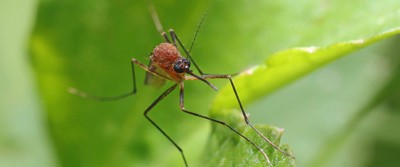New Solution Uses Bacterial Compounds to Repel Mosquitoes

By Iva Fedorka
A recently discovered species of roundworm is host to a bacteria whose molecules may be able to keep mosquitoes away. This discovery provides a potential new option, and may prove to be as effective as commercially available mosquito repellants.
Worms and Bacteria
The mosquito-repelling compounds are produced by Xenorhabdus budapestensis, a bacterium that has a symbiotic relationship with Steinernema bicornutum. Thisroundworm or nematode lives in Eastern Europe, and was only recently identified as a unique species. Like many other bacteria in the same family, S. bicornutum is parasitic and can transfer bacteria (via defecation) to caterpillars and other insect hosts. The transferred bacteria weakens the host’s immune system and eventually digests its internal organs.
In the laboratory, infecting mosquitoes with X. budapestensis was shown to be as effective at stopping them as treatments with DEET (N,N-diethyl-3-methylbenzamide) or picaridin, two common commercial repellants. Scientists have found that other bacteria in the same genus also produce insect-killing compounds, but this is the first time that bacterial compounds have been shown to ward off adult mosquitoes.
Although DEET is considered safe for human use, alternative deterrents to disease-transmitting insects are always a positive development. These molecules were effective against three major mosquito species:
- Aedes aegypti mosquitoes can carry Zika, dengue and yellow fever viruses
- Anopheles gambiae is a major malaria carrier
- Culex pipiens carries the West Nile virus
The bacterial molecules may have evolved to prevent other insects from stealing the nematodes’ kills. Curiously, the compounds work effectively against mosquitoes, although the soil-dwelling nematode source of the microbes is unlikely to overlap with mosquito territory in the wild.
Fabclavines as Repellants
Que Lan, the original researcher at the University of Wisconsin – Madison, was looking for microbes that might generate insect-killing molecules. In one experiment, Lan’s team tried to test whether the molecules worked as an insecticide by feeding mosquitoes from cotton balls dipped in extracts from the X. budapestensis bacteria. But “the mosquitoes wouldn’t go near the cotton balls,” said Susan Paskewitz, the researcher who inherited the project after Lan died unexpectedly. “Something seemed to repel the insects before they even got a taste. That was fascinating.”
Paskewitz and her colleagues cultured more of the bacteria, extracted the molecules, and then added the extracts to artificial blood brews. The team created multiple extracts by separating the molecules by physical characteristics. They watched the mosquitoes feed in the lab, noting that extracts rich in molecules called fabclavines were the most effective in deterring mosquitoes from eating their food.
Promising Developments
Paskewitz and her colleagues plan further testing, which include growing bacteria that lack the gene for making fabclavines to test whether those compounds are truly responsible. Even if that phase of testing is successful, it would still be a long time before a commercial product would be available for your next camping trip. Researchers need to test for toxicity and confirm that the molecules are effective not just in the lab but in a real-world context.
Discussion Questions
- What kind of an organism causes malaria?
- What other diseases are carried by viruses?
Vocabulary
- Vector
- Nematode
- Symbiosis
